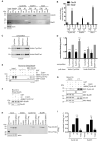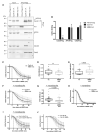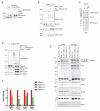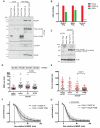The ABBA motif binds APC/C activators and is shared by APC/C substrates and regulators
- PMID: 25669885
- PMCID: PMC4713905
- DOI: 10.1016/j.devcel.2015.01.003
The ABBA motif binds APC/C activators and is shared by APC/C substrates and regulators
Abstract
The anaphase-promoting complex or cyclosome (APC/C) is the ubiquitin ligase that regulates mitosis by targeting specific proteins for degradation at specific times under the control of the spindle assembly checkpoint (SAC). How the APC/C recognizes its different substrates is a key problem in the control of cell division. Here, we have identified the ABBA motif in cyclin A, BUBR1, BUB1, and Acm1, and we show that it binds to the APC/C coactivator CDC20. The ABBA motif in cyclin A is required for its proper degradation in prometaphase through competing with BUBR1 for the same site on CDC20. Moreover, the ABBA motifs in BUBR1 and BUB1 are necessary for the SAC to work at full strength and to recruit CDC20 to kinetochores. Thus, we have identified a conserved motif integral to the proper control of mitosis that connects APC/C substrate recognition with the SAC.
Copyright © 2015 Elsevier Inc. All rights reserved.
Figures







Similar articles
-
Bub1 and aurora B cooperate to maintain BubR1-mediated inhibition of APC/CCdc20.J Cell Sci. 2005 Aug 15;118(Pt 16):3639-52. doi: 10.1242/jcs.02487. Epub 2005 Jul 26. J Cell Sci. 2005. PMID: 16046481
-
The Mitotic Checkpoint Complex Requires an Evolutionary Conserved Cassette to Bind and Inhibit Active APC/C.Mol Cell. 2016 Dec 15;64(6):1144-1153. doi: 10.1016/j.molcel.2016.11.006. Epub 2016 Dec 8. Mol Cell. 2016. PMID: 27939943 Free PMC article.
-
Dissecting the roles of human BUB1 in the spindle assembly checkpoint.J Cell Sci. 2015 Aug 15;128(16):2975-82. doi: 10.1242/jcs.169821. Epub 2015 Jul 6. J Cell Sci. 2015. PMID: 26148513
-
The spindle checkpoint: how do cells delay anaphase onset?SEB Exp Biol Ser. 2008;59:243-56. SEB Exp Biol Ser. 2008. PMID: 18368927 Review.
-
Mitotic regulation of the anaphase-promoting complex.Cell Mol Life Sci. 2007 Mar;64(5):589-600. doi: 10.1007/s00018-007-6443-1. Cell Mol Life Sci. 2007. PMID: 17334950 Free PMC article. Review.
Cited by
-
BubR1 recruitment to the kinetochore via Bub1 enhances spindle assembly checkpoint signaling.Mol Biol Cell. 2022 Sep 1;33(10):br16. doi: 10.1091/mbc.E22-03-0085. Epub 2022 Jun 29. Mol Biol Cell. 2022. PMID: 35767360 Free PMC article.
-
Cryo-EM structures of apo-APC/C and APC/CCDH1:EMI1 complexes provide insights into APC/C regulation.Nat Commun. 2024 Nov 21;15(1):10074. doi: 10.1038/s41467-024-54398-5. Nat Commun. 2024. PMID: 39567505 Free PMC article.
-
A novel mutation in the N-terminal domain of Drosophila BubR1 affects the spindle assembly checkpoint function of BubR1.Biol Open. 2016 Nov 15;5(11):1674-1679. doi: 10.1242/bio.021196. Biol Open. 2016. PMID: 27742609 Free PMC article.
-
APCCdh1-mediated degradation of Cdh1 is necessary for faithful meiotic chromosome segregation in S. cerevisiae.bioRxiv [Preprint]. 2024 Jul 2:2024.07.01.601619. doi: 10.1101/2024.07.01.601619. bioRxiv. 2024. PMID: 39005361 Free PMC article. Preprint.
-
Kinetochore-catalyzed MCC formation: A structural perspective.IUBMB Life. 2023 Apr;75(4):289-310. doi: 10.1002/iub.2697. Epub 2022 Dec 14. IUBMB Life. 2023. PMID: 36518060 Free PMC article.
References
-
- Chao WC, Kulkarni K, Zhang Z, Kong EH, Barford D. Structure of the mitotic checkpoint complex. Nature. 2012;484:208–213. - PubMed
Publication types
MeSH terms
Substances
Grants and funding
LinkOut - more resources
Full Text Sources
Other Literature Sources
Molecular Biology Databases
